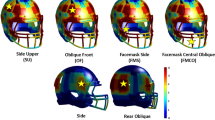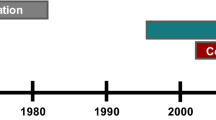Abstract
The relationship between laboratory and on-field performance of football helmets was assessed for 31 football helmet models selected from those worn by players in the 2015–2019 National Football League (NFL) seasons. Linear impactor tests were conducted with helmets placed on an instrumented Hybrid III head and neck assembly mounted on a sliding table. Based on impacts to each helmet at six impact locations and three velocities, a helmet performance score (HPS) was calculated using a linear combination of the head injury criterion (HIC) and the diffuse axonal multi-axis general evaluation (DAMAGE). To determine the on-field performance of helmets, helmet model usage, player participation, and incident concussion data were collected from the five NFL seasons and used to calculate helmet model-specific concussion rates. Comparison of laboratory HPS to the helmet model-specific concussion rates on a per play basis showed a positive correlation (r2 = 0.61, p < 0.001) between laboratory and on-field performance of helmet models, indicating that helmets which exhibited reduced impact severity in the laboratory tests were also generally associated with lower concussion rates on-field. Further analysis showed that NFL-prohibited helmet models exhibited a significantly higher odds of concussion (OR 1.24; 95% CI 1.04–1.47; p = 0.017) relative to other helmet models.



Similar content being viewed by others
References
Abrahams, S., S. M. Fie, J. Patricios, M. Posthumus, and A. V. September. Risk factors for sports concussion: an evidence-based systematic review. Br. J. Sports Med. 48:91–97, 2014.
Adirim, T. A. Concussions in sports and recreation. Clin. Pediatr. Emerg. Med. 8:2–6, 2007.
Bailey, A. B., E. J. Sanchez, G. Park, L. F. Gabler, J. Funk, J. Crandall, B. S. Myers, and K. B. Arbogast. Development and evaluation of a test method for assessing the performance of American football helmets. Ann. Biomed. Eng. 2020. https://doi.org/10.1007/s10439-020-02626-6.
Bates, D., M. Mächler, B. Bolker, and S. Walker. Fitting linear mixed-effects models using lme4. J. Stat. Softw. 67:1–48, 2015.
Benson, B. W., A. S. McIntosh, D. Maddocks, S. A. Herring, M. Raftery, and J. Dvořák. What are the most effective risk-reduction strategies in sport concussion? Br. J. Sports Med. 47:321–326, 2013.
Broglio, S. P., T. Surma, and J. A. Ashton-Miller. High school and collegiate football athlete concussions: a biomechanical review. Ann. Biomed. Eng. 40:37–46, 2012.
Buckley, W. E. Concussions in college football: a multivariate analysis. Am. J. Sports Med. 16:51–56, 1988.
Cantu, R. C., and F. O. Mueller. Brain injury-related fatalities in American football, 1945–1999. Neurosurgery 52:846–853, 2003.
Collins, C. L., L. B. McKenzie, A. K. Ferketich, R. Andridge, H. Xiang, and R. D. Comstock. Concussion characteristics in high school football by helmet age/recondition status, manufacturer, and model: 2008-2009 through 2012-2013 academic years in the United States. Am. J. Sports Med. 44:1382–1390, 2016.
Collins, M., M. R. Lovell, G. L. Iverson, T. Ide, and J. Maroon. Examining concussion rates and return to play in high school football players wearing newer helmet technology: a three-year prospective cohort study. Neurosurgery 58:275–286, 2006.
Concato, J., P. Peduzzi, T. R. Holford, and A. R. Feinstein. Importance of events per independent variable in proportional hazards analysis I. Background, goals, and general strategy. J. Clin. Epidemiol. 48:1495–1501, 1995.
Centers for Disease Control and Prevention. Sports-related recurrent brain injuries—United States. MMWR Morb. Mortal. Wkly. Rep. 46(10):224–227, 1997.
Covassin, T., C. B. Swanik, and M. L. Sachs. Epidemiological considerations of concussions among intercollegiate athletes. Appl. Neuropsychol. 10:12–22, 2003.
Crisco, J. J., R. Fiore, J. G. Beckwith, J. J. Chu, P. G. Brolinson, S. Duma, T. W. McAllister, A.-C. Duhaime, and R. M. Greenwald. Frequency and location of head impact exposures in individual collegiate football players. J. Athl. Train. 45:549–559, 2010.
Daneshvar, D. H., C. M. Baugh, C. J. Nowinski, A. C. McKee, R. A. Stern, and R. C. Cantu. Helmets and mouth guards: the role of personal equipment in preventing sport-related concussions. Clin. Sports Med. 30:145–163, 2011.
DiMasi, F. P. Transformation of Nine-Accelerometer-Package (NAP) Data for Replicating Headpart Kinematics and Dynamic Loading. Washington, DC: National Highway Traffic Safety Administration, 1995.
Dreyer, N. A., C. D. Mack, R. B. Anderson, E. M. Wojtys, E. B. Hershman, and A. Sills. Lessons on data collection and curation from the NFL injury surveillance program. Sports Health 11:440–445, 2019.
Ellenbogen, R. G., H. Batjer, J. Cardenas, M. Berger, J. Bailes, E. Pieroth, and R. Heyer. National football league head, neck and spine committee’s concussion diagnosis and management protocol: 2017-18 season. Br. J. Sports Med. 52:894–902, 2018.
Gabler, L. F., A. M. Bailey, J. R. Funk, J. R. Crandall, K. B. Arbogast, and B. S. Myers. Development of a metric for ranking the performance off football helmets. In: Proceedings of the 2019 Biomedical Engineering Society Conference, Philadelphia, PA, 2019.
Gabler, L. F., J. R. Crandall, and M. B. Panzer. Development of a metric for predicting brain strain responses using head kinematics. Ann. Biomed. Eng. 46:972–985, 2018.
Guskiewicz, K. M., M. McCrea, S. W. Marshall, R. C. Cantu, C. Randolph, W. Barr, J. A. Onate, and J. P. Kelly. Cumulative effects associated with recurrent concussion in collegiate football players: the NCAA concussion study. JAMA 290:2549–2555, 2003.
Guskiewicz, K. M., J. P. Mihalik, V. Shankar, S. W. Marshall, D. H. Crowell, S. M. Oliaro, M. F. Ciocca, and D. N. Hooker. Measurement of head impacts in collegiate football players: relationship between head impact biomechanics and acute clinical outcome after concussion. Neurosurgery 61:1244–1253, 2007.
Kawata, K., L. H. Rubin, J. H. Lee, T. Sim, M. Takahagi, V. Szwanki, A. Bellamy, K. Darvish, S. Assari, J. D. Henderer, R. Tierney, and D. Langford. Association of football subconcussive head impacts with ocular near point of convergence. JAMA Ophthalmol. 134:763–769, 2016.
Kuo, C., L. Wu, J. Loza, D. Senif, S. C. Anderson, and D. B. Camarillo. Comparison of video-based and sensor-based head impact exposure. PLoS ONE 13:e0199238, 2018.
Lessley, D., R. Kent, C. Sherwood, J. Cormier, J. Crandall, K. B. Arbogast, and B. S. Myers. Video analysis of reported concussion events in the National Football League during the 2015-2016 and 2016-2017 seasons. Am. J. Sports Med. 46(14):3502–3510, 2018.
McGuine, T. A., S. Hetzel, M. McCrea, and M. A. Brooks. Protective equipment and player characteristics associated with the incidence of sport-related concussion in high school football players: a multifactorial prospective study. Am. J. Sports Med. 42:2470–2478, 2014.
Mihalik, J. P., D. R. Bell, S. W. Marshall, and K. M. Guskiewicz. Measurement of head impacts in collegiate football players: an investigation of positional and event-type differences. Neurosurgery 61:1229–1235, 2007.
Moran, R., and T. Covassin. An examination of concussion injury rates in various models of football helmets in NCAA football athletes. J. Sports Sci. 3:29–34, 2015.
National Football League. Health and safety rule changes, 2020. https://operations.nfl.com/football-ops/nfl-ops-honoring-the-game/health-safety-rules-changes/.
National Football League, and National Football League Players Association. NFL NFLPA 2020 helmet laboratory testing performance results, 2020. https://www.playsmartplaysafe.com/resource/helmet-laboratory-testing-performance-results/.
National Football League Players Association. NFL and NFLPA release 2018 helmet laboratory testing performance results, 2018. https://nflpa.com/press/2018-helmet-lab-testing-performance-results.
NOCSAE. Standard performance specification for newly manufactured football helmets. National Operating Committee on Standards for Athletic Equipment, 2015. http://nocsae.org/wp-content/files_mf/1436291444ND00213m15MfrdFBHelmetsStandardPerformance.pdf.
National Operating Committee on Standards for Athletic Equipment. Standard linear impactor test method and equipment used in evaluating the performance characteristics of protective headgear and face guards (ND 081-18am19a), 2019.
Ocwieja, K. E., J. P. Mihalik, S. W. Marshall, J. D. Schmidt, S. C. Trulock, and K. M. Guskiewicz. The effect of play type and collision closing distance on head impact biomechanics. Ann. Biomed. Eng. 40:90–96, 2012.
Peduzzi, P., J. Concato, E. Kemper, T. R. Holford, and A. R. Feinstein. A simulation study of the number of events per variable in logistic regression analysis. J. Clin. Epidemiol. 49:1373–1379, 1996.
Pellman, E. J., J. W. Powell, D. C. Viano, I. R. Casson, A. M. Tucker, H. Feuer, M. Lovell, J. F. Waeckerle, and D. W. Robertson. Concussion in professional football: epidemiological features of game injuries and review of the literature—part 3. Neurosurgery 54:81–96, 2004.
Pellman, E. J., D. C. Viano, C. Withnall, N. Shewchenko, C. A. Bir, and P. D. Halstead. Concussion in professional football: helmet testing to assess impact performance—part 11. Neurosurgery 58:78–95, 2006.
Rowson, S., G. Brolinson, M. Goforth, D. Dietter, and S. Duma. Linear and angular head acceleration measurements in collegiate football. J. Biomech. Eng. 131:061016, 2009.
Rowson, S., and S. M. Duma. Development of the STAR evaluation system for football helmets: integrating player head impact exposure and risk of concussion. Ann. Biomed. Eng. 39:2130–2140, 2011.
Rowson, S., S. M. Duma, R. M. Greenwald, J. G. Beckwith, J. J. Chu, K. M. Guskiewicz, J. P. Mihalik, J. J. Crisco, B. J. Wilcox, T. W. McAllister, et al. Can helmet design reduce the risk of concussion in football? Technical note. J. Neurosurg. 120:919–922, 2014.
Schulz, M. R. Incidence and risk factors for concussion in high school athletes, North Carolina, 1996-1999. Am. J. Epidemiol. 160:937–944, 2004.
Society of Automotive Engineers. J211-1 instrumentation for impact test—Part 1—electronic instrumentation. SAE Int. J211/1_201403, 2014.
Sone, J. Y., D. Kondziolka, J. H. Huang, and U. Samadani. Helmet efficacy against concussion and traumatic brain injury: a review. J. Neurosurg. 126:768–781, 2017.
Stemper, B. D., A. S. Shah, J. Harezlak, et al. Repetitive head impact exposure in college football following an NCAA rule change to eliminate two-a-day preseason practices: a study from the NCAA-DoD CARE Consortium. Ann. Biomed. Eng. 47:2073–2085, 2019.
Thurman, D. J., C. M. Branche, and J. E. Sniezek. The epidemiology of sports-related traumatic brain injuries in the United States: recent developments. J. Head Trauma Rehabil. 13:1–8, 1998.
Tyson, A. M., and S. Rowson. Varsity football helmet STAR protocol, 2018.
Versace, J. A Review of the Severity Index. SAE Technical Paper, 1971.
Viano, D. C., and D. Halstead. Change in size and impact performance of football helmets from the 1970s to 2010. Ann. Biomed. Eng. 40:175–184, 2012.
Viano, D. C., C. Withnall, and D. Halstead. Impact performance of modern football helmets. Ann. Biomed. Eng. 40:160–174, 2012.
Zemper, E. D. Analysis of cerebral concussion frequency with the most commonly used models of football helmets. J. Athl. Train. 29:44–50, 1994.
Zemper, E. D. Two-year prospective study of relative risk of a second cerebral concussion. Am. J. Phys. Med. Rehabil. 82:653–659, 2003.
Acknowledgments
The research presented in this paper was made possible by a grant from Football Research, Inc. (FRI). FRI is a nonprofit corporation that receives funding from sources including the NFL and is dedicated to the research and development of novel methods to prevent, mitigate, and treat traumatic head injury. The views expressed are solely those of the authors and do not represent those of FRI or any of its affiliates or funding sources. Dr. McMurry’s contributions resulted from his affiliation with T.L. McMurry, LLC and the views presented do not represent the views of or an endorsement by the University of Virginia. Authors Arbogast and Myers’s contributions resulted from their affiliation as paid consultants to the NFL Players Association. The authors would also like to acknowledge Biokinetics and Associates, Ltd., Next Generation Stats, IQVIA, Helmet Tracker, NFL Information Technology, and NFL team equipment and medical staff for contributing to the data collection and compilation for this study.
Author information
Authors and Affiliations
Corresponding author
Additional information
Associate Editor Stefan M. Duma oversaw the review of this article.
Publisher's Note
Springer Nature remains neutral with regard to jurisdictional claims in published maps and institutional affiliations.
Rights and permissions
About this article
Cite this article
Bailey, A.M., McMurry, T.L., Cormier, J.M. et al. Comparison of Laboratory and On-Field Performance of American Football Helmets. Ann Biomed Eng 48, 2531–2541 (2020). https://doi.org/10.1007/s10439-020-02627-5
Received:
Accepted:
Published:
Issue Date:
DOI: https://doi.org/10.1007/s10439-020-02627-5




